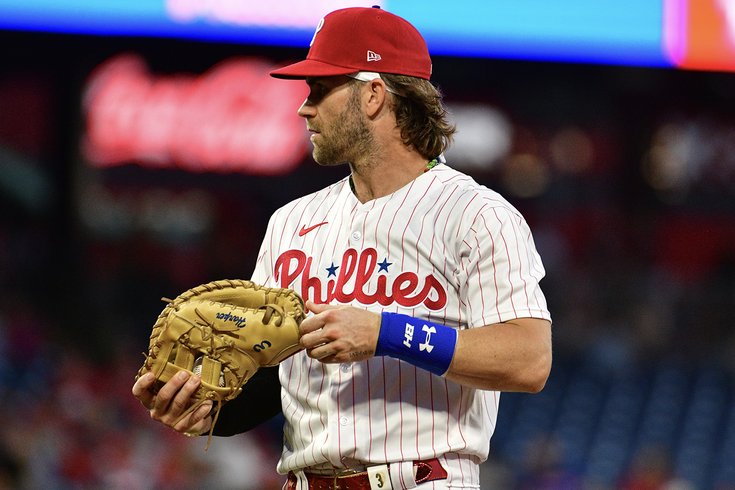
February 14, 2024
 Kate Frese/For PhillyVoice
Kate Frese/For PhillyVoice
Phillies first baseman Bryce Harper against the Braves on September 13, 2023 at Citizens Bank Park.
Over the last few winters, we've passed the time by ranking things. We ranked every Eagles player, and Sixers player by position while also throwing in some other lists that weren't quite as fun.
For the next two weeks, leading up to pitchers and catchers reporting to Clearwater for the 2024 Phillies season, we decided to take a look at each position in the Phillies storied 100+ year history and come up with a list of the all-time greats at each position.
We're going to limit our lists to 10 (with a few extra mentions) in part because there have been more than 2,000 different players to appear in at least one game for the Phillies. But we did look at everybody.
Continuing with right field we had a few requirements. We strived for players who started at the position for at least three seasons in Philadelphia (but we made a few exceptions) and their statistical and cultural impact were both weighed when making these rankings.
If you were waiting to see where all the power was, historically for the Phillies, it's definitely at right field. Before we dive into our top 10, here's a look at a handful of right fielders who either didn't qualify or make the cut talent-wise:
| Player | Games | Notes |
| Nick Castellanos | 293 | .268/.308/.437 |
| Jayson Werth | 543 | 2009 All-Star |
| Glenn Wilson | 602 | 1985 All-Star |
| Bake McBride | 533 | .292/.335/.435 |
| Jay Johnstone | 462 | .303/.368/.455 |
| Ron Northey | 600 | .269/.335/.428 |
And now our list of the 10 best right fielders in Phillies history — which starts with a newly minted first baseman:
Shamus Clancy: When it's all said and done, Harper may go down as the second-greatest Phillies hitter ever behind Michael Jack Schmidt. He'll need a World Series parade to solidify that standing, but Harper has been worth every penny and more from the massive contract he signed ahead of the 2019 season.
In 30 career postseason games as a Phillie, Harper is hitting .324 with a 1.137 OPS, plus 11 home runs. In Barry Bonds' back-to-back MVP seasons with Pittsburgh and San Francisco in 1992-1993, Bonds hit .324 with a 1.109 OPS. So, Harper basically turns into the best hitter of all time when the lights are brightest.
The swing of his life? It might only be the swing of his life so far.
Nick Tricome: Abreu was the model of consistency at the plate, the first to homer at Citizens Bank Park, and the Home Run Derby champ. He was a great Phillie through a whole lot of lean years and unfortunately got traded away to the Yankees in 2006 just before things started getting good.
Nick: A fan-favorite power hitter through the 1960s – though that included having to brunt the '64 collapse – Callison seemingly could do it all out in the field and at the plate, including walking off the All-Star Game.
Shamus: This dude absolutely raked during his first stint with the Fightins. From 1929 to 1933, Klein had four top-four MVP finishes with a triple slash line of .359/.414/.637 while averaging 36 home runs and 139 RBI per year. Given that he wore a staggering nine different numbers during his Phillies career (and had a couple seasons that predated uniform numbers), he is honored with just a "P" at Citizens Bank Park among the other retired numbers.
Evan Macy: Hayes might be more well known for the trade that brought him to Philly than for his actual play in the city. He was famously acquired in a rare five-for-one deal, with Cleveland receiving Jay Baller, Julio Franco, Manny Trillo, George Vukovich and Jerry Willard for him as a second-year player. It's routinely cited as one of the worst swaps in franchise history, but he wasn't a bad player by any measure and the players sent away in exchange for his services weren't superstars either.
Evan: Obviously take these early, 19th-century baseball stats with a grain of salt, but Thompson is in Cooperstown due to being one of the best hitters of his day. He led the majors in slugging, total hits and RBI three times, in home runs twice and in 1887 (100 years before I was born!) he his .372 with 166 RBI and would likely have won an MVP award if it existed — it wouldn't for another 24 years.
Shamus: While the peak of Flick's Hall of Fame career came with the Cleveland Naps, he was an extra-bases machine during his four years with the Phils. He had at least 11 triples in every season, hit 30-plus doubles twice and led the sport in RBI in 1900 with 110. He swiped at least 30 bags in three seasons, too.
Evan: Cravath held the home run record that Babe Ruth broke which is kind of cool. He had quite the power bat for the 1910s, hitting the most homers of any NL player in six of seven seasons from 1913-19. In 1913 he hit 19 homers, 128 RBI and hit .347. He came in second for MVP behind Brooklyn's Jake Daubert who had a worse season, but did hit .350.
Nick: Eisenreich posted his best numbers in Philadelphia, slashing .318 on the way to the World Series in '93, then continuing to shine even after the decline with a staggering .361 batting average in '96. Then he left for the Marlins the year after and won the World Series.
Follow Evan on Twitter:@evan_macy
Like us on Facebook: PhillyVoice Sports